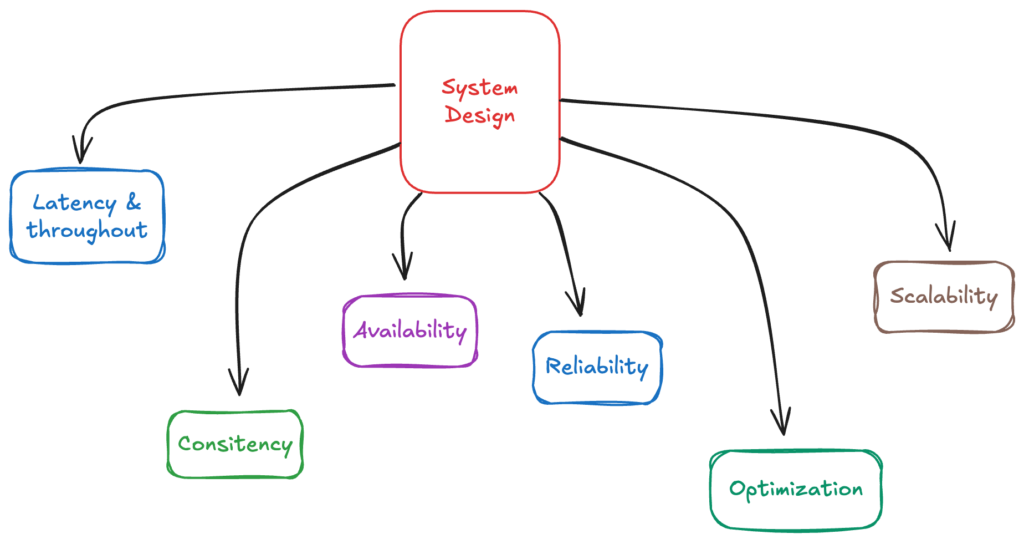What is System Design ?
System Design is the process of defining the architecture, components, modules, interfaces, and data for a system to satisfy specific requirements. It involves creating a blueprint for a software system that ensures it is scalable, reliable, maintainable, and efficient.
System design is a crucial skill for software engineers, especially those working on large-scale, distributed systems. It bridges the gap between abstract requirements and a concrete, functioning system.
Why is System Design Important?
- Scalability: Ensures the system can handle increased traffic or data.
- Reliability: Ensures the system works correctly under expected and unexpected conditions.
- Maintainability: Makes it easier to update and debug the system.
- Performance: Optimizes the system to meet performance benchmarks.
- Cost Efficiency: Balances resource usage and operational costs.

Key Components of System Design
High-Level Design (HLD)
HLD focuses on the overall architecture of the system. It defines:
- Major components and their relationships.
- Technology choices (e.g., databases, frameworks, protocols).
- Data flow and interaction between modules.
Example
Designing a ride-sharing app like Uber:
- Components:
- User Service (handles user profiles).
- Ride Service (handles ride requests).
- Payment Service (processes payments).
- Notification Service (sends updates to users).
- Technologies:
- Backend: Node.js, Java, or Python.
- Database: MySQL for relational data, Redis for caching.
- Communication: REST APIs or gRPC.
Low-Level Design (LLD)
LLD focuses on the detailed implementation of each component. It includes:
- Class diagrams and database schemas.
- Algorithms and logic for each module.
- Detailed API specifications.
Example
For the User Service:
- Database Schema:
CREATE TABLE Users (
id INT PRIMARY KEY AUTO_INCREMENT,
name VARCHAR(255),
email VARCHAR(255) UNIQUE,
phone VARCHAR(20),
created_at TIMESTAMP DEFAULT CURRENT_TIMESTAMP
);
API Specification:
POST /users: Create a new user.GET /users/{id}: Fetch user details by ID.
Core Concepts in System Design
Scalability
The ability of a system to handle increased load.
Types of Scalability
- Vertical Scaling: Adding more resources (CPU, RAM) to a single server.
- Horizontal Scaling: Adding more servers to distribute the load.
Example
For a social media platform:
- Use a Load Balancer to distribute user requests across multiple servers.
- Store user data in a distributed database like Cassandra.
Reliability
Ensuring the system works as expected under various conditions.
Techniques for Reliability
- Redundancy: Have backup servers or databases.
- Failover Mechanisms: Automatically switch to a backup system in case of failure.
- Monitoring: Use tools like Prometheus or Datadog to track system health.
Example
A payment gateway must ensure reliability:
- Use multiple payment processors to avoid downtime.
- Implement retry logic for failed transactions.
Availability
The percentage of time the system is operational.
Formula
Availability=Uptime/(Uptime+downTime) x 100
Techniques for High Availability
- Use Replication to duplicate data across servers.
- Employ CDNs (Content Delivery Networks) to serve content closer to users.
Consistency
Ensuring all users see the same data at the same time.
Types of Consistency
- Strong Consistency: All reads return the latest write.
- Eventual Consistency: Data will become consistent over time (e.g., in distributed systems).
Example
For a messaging app:
- Use a distributed database like DynamoDB with eventual consistency for chat history.
Latency and Throughput
- Latency: The time taken to process a request.
- Throughput: The number of requests processed per second.
Optimization Techniques
- Use caching (e.g., Redis, Memcached) to reduce database queries.
- Implement CDNs for static assets like images and videos.
System Design Process
Step 1: Gather Requirements
Understand the functional and non-functional requirements.
- Functional: Features the system must have (e.g., user login, notifications).
- Non-functional: Performance, scalability, reliability
Step 2: Define High-Level Design
- Identify major components and their interactions.
- Choose appropriate technologies.
Step 3: Define Low-Level Design
- Create detailed class diagrams and database schemas.
- Write algorithms for key features.
Step 4: Address Non-Functional Requirements
- Add caching for performance.
- Use replication and failover for reliability.
Step 5: Iterate and Optimize
- Monitor system performance.
- Refactor and scale components as needed.
Challenges in System Design
- Handling Failures: Use retries, fallbacks, and monitoring.
- Scaling Databases: Use sharding or partitioning.
- Ensuring Security: Use encryption, authentication, and authorization.
System design is the art of creating software systems that are scalable, reliable, and maintainable. It involves understanding requirements, defining architecture, and optimizing for performance. Mastering system design is essential for building robust systems and excelling in technical interviews. Happy coding ! ❤️
